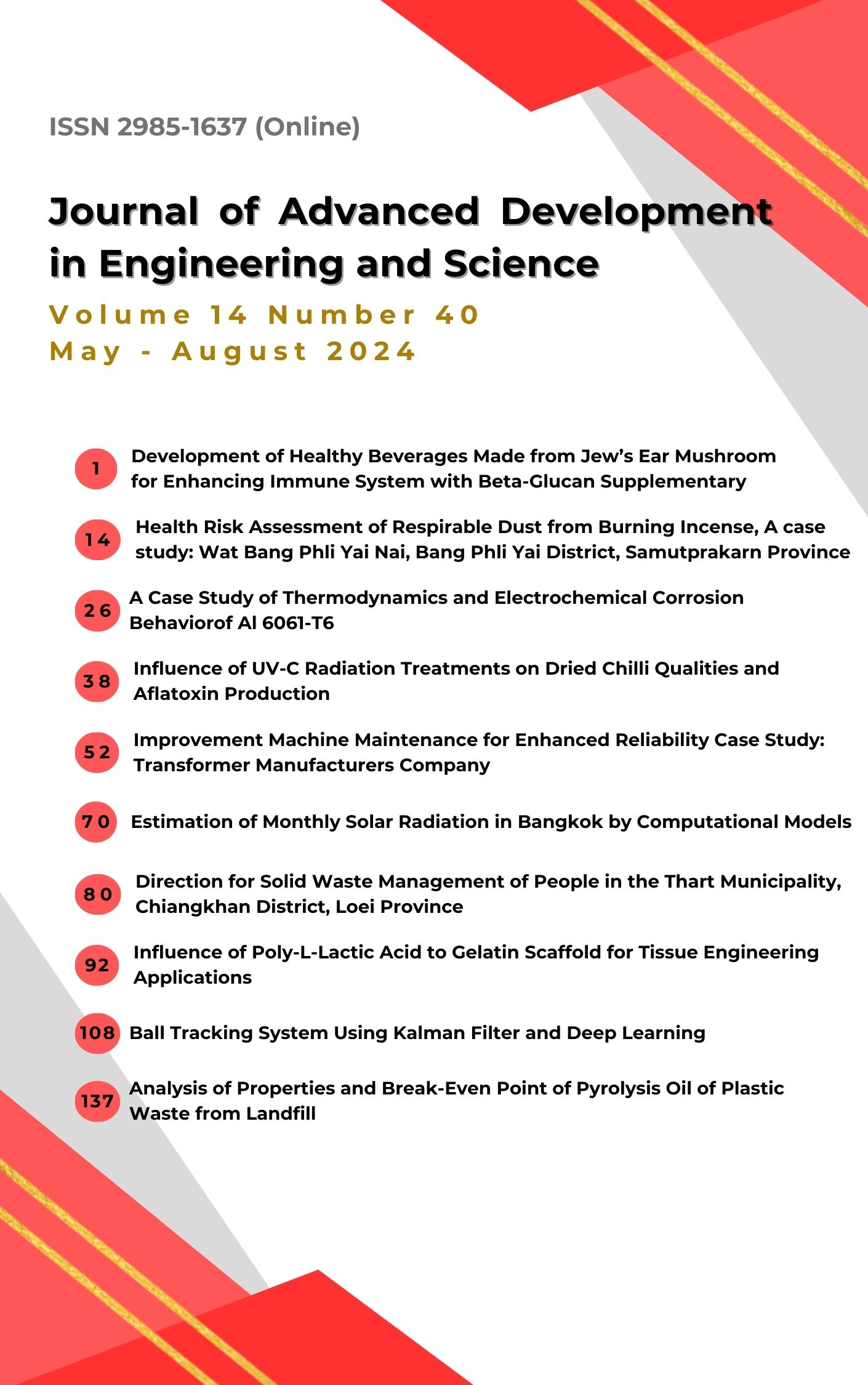Health Risk Assessment of Respirable Dust from Burning Incense, A case study: Wat Bang Phli Yai Nai, Bang Phli Yai District, Samutprakarn Province
Main Article Content
Abstract
Incense smoke is cause many types of air pollutants. If exposed in high volume and long period, it may cause related to the respiratory diseases. This study aimed to assess the health effects of incense smoke at Wat Bang Phli Yai Nai in Samut Prakan Province. The objective was to measure the concentrations of Respirable Dust (RD) and Particulate Matter less than 2.5 microns (PM 2.5), which impact the health of workers. A personal air sampler pump and an indoor air quality monitor duration December 16 – 22, 2023 and collected health information including working time, weight, and exposure time of workers 24 person. Then were used for the health risk assessment. The results showed that the average concentrations of RD and PM2.5 were 0.551 mg/m³ and 0.079 + 0.054 mg/m³, respectively. The health risk assessment indicated that the Hazard Quotient (HQ) levels for RD and PM2.5 averaged 5.029 and 1.586, respectively, both exceeding the threshold value of 1. This indicates a significant health risk from exposure to these pollutants. Therefore, it is necessary to find corrective and preventive measures such as, cancel lighting incense and candles, install a ventilation system and wearing mask etc.
Article Details

This work is licensed under a Creative Commons Attribution-NonCommercial-NoDerivatives 4.0 International License.
The content and information in articles published in the Journal of Advanced Development in Engineering and Science are the opinions and responsibility of the article's author. The journal editors do not need to agree or share any responsibility.
Articles, information, content, etc. that are published in the Journal of Advanced Development in Engineering and Science are copyrighted by the Journal of Advanced Development in Engineering and Science. If any person or organization wishes to publish all or any part of it or to do anything. Only prior written permission from the Journal of Advanced Development in Engineering and Science is required.
References
Busanian, U. (2016). Marketing patterns and strategy's the joss sitck making entrepreneur in changwat Nakhon Pathom, (Master thesis, Silpakorn University). (in Thai)
Health Impact Assessment Division, Department of Health. (2019) Health effects from incense smoke, incense ashes, vapors and ashes from burning high volume of silver and gold paper during the Chinese New Year Festival, Available from https://multimedia. anamai.moph.go.th /help-knowledgs/incense. Accessed date: 27 January 2023. (in Thai)
Department of Health and Department of Disease Control, Ministry of Public Health. (2015). Guidelines for monitoring health risk areas from air pollution In the case of Particulate Matter. Available from http://hia.anamai.moph.go.th/download/hia/ manual/book/book44.pdf. Accessed date: 27 January 2023. (in Thai)
Senthong, P., et al. (2020). The Study of Respirable Dust, Carbon Dioxide and Oxygen Concentration Due to Incense Burning in Temples in Mueang District, Surat Thani province. KKU Research Journal (Graduate Studies), 20(4), 165-174. (in Thai)
Ketsakhon, A. & Sanawin, N. (2017). Relationship between Particle-bound Polycyclic Aromatic Hydrocarbon and PM10 with Environmental Factors: A Case Study on a Religion Place in Pathum Thani Province. The Journal of KMUTNB, 27(3), 493-500. (in Thai)
Occupational Safety and Health Administration. (1988). OSHA PEL Project Documentation. Available from http://www.cdc.gov. Accessed date: 27 January 2024.
Bootdee, S., et al. (2016). Determination of PM2.5 and polycyclic aromatic hydrocarbons from incense burning emission at shrine for health risk assessment. Atmospheric Pollution Research, 7(4), 680-689.
Wang, B., et al. (2007). Characteristics of emissions of air pollutants from burning of incense in temples, Hong Kong. Science of The Total Environment, 377(1), 52-60.
Samut Prakan Tourism and Sports Office. (2018). Wat Bang Phli Yai Nai (Luang Pho To Temple). Available from https://www.mots.go.th. Accessed date: 30 June 2023. (in Thai)
Salapsri, S. & Wattanapongsiri, P. (2020). The Management of Sustainable Community-Based Tourism: A Case Study of Bangplee Floating Market and Wat Bangplee Yainai, Samutprakarn. Academy Journal of Northern, 7(1), 1-15. (in Thai)
Department of Health, Ministry of Public Health (2022) Announcement of the Department of Health regarding air quality monitoring for public buildings, 2022. (in Thai)
Samut Prakan Provincial Public Health Office. (2023). Number of illnesses (per disease) related to air pollution Samut Prakan Province, year 2023. Available from https://spk.hdc.moph.go.th. Accessed date: 8 March 2024. (in Thai)
Kongdee, W. (2020). Health Risk Assessment. Available from https://www.ohswa.or.th. Accessed date: 3 December 2023. (in Thai)
Bunmee, N. (2019). Risk Assessment of Particulate Matter Less Than 10 Micrometers;
A Case Study in Crushing Plant, Chon Buri, (Master thesis, Burapha University). (in Thai)
Hien, T. T., et al. (2022). Characterization of Particulate Matter (PM1 and PM2.5) from Incense Burning Activities in Temples in Vietnam and Taiwan. Aerosol and Air Quality Research, 22(11), 220193.
Pollution Control Department. (2010). Announcement of the National Environment Board (No. 36) B.E 2553. Title: Regarding Setting Standards for Particulate Matter with Diameter of Less Than 2.5 Micron in the General Atmosphere. (in Thai)
Department of Health and Disease Control, Ministry of Public Health. (2014). Environmental health risk assessment manual for control businesses that are hazardous to health according to the Public Health Act B.E. 2535. Nonthaburi: Health Impact Assessment Division, Department of Health. (in Thai)
Wong, A., et al. (2020). Indoor incense burning impacts cognitive functions and brain functional connectivity in community older adults. Scientific Reports, 10, 7090.
Wiwattanadet, P. (2012). Manual for monitoring results Impact on health from air pollution. Nonthaburi: Department of Health, Ministry of Public Health. (in Thai)

